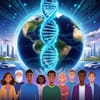Artificial intelligence is on the cusp of a revolutionary transformation, shifting from statistical models to world-aware intelligences that perceive, evolve, and co-create alongside humans. This new paradigm is inspired by the structure and function of DNA, where knowledge and reality are encoded in a digital format, enabling AI systems to simulate and understand complex phenomena.
The concept of AI DNA involves creating a digital blueprint that captures the rules of physics, the memory of history, and the imagination to create new worlds. This would allow AI to simulate ecosystems, forecast evolutionary pathways of industries and societies, and generate alternative worlds. For instance, AI could simulate how a rainforest might adapt under climate stress or forecast the evolutionary pathways of industries and technologies. Evolutionary Knowledge: AI systems would carry an evolutionary tree of knowledge, enabling them to understand the development of languages, species, or industries over time.
Sensory Perception: AI would be equipped with digital senses, including vision, audio, and touch, allowing it to perceive and interact with the world like living beings. World-Building: AI could generate alternative worlds, enabling researchers to test hypotheses and validate applications in controlled environments.
The potential applications of AI DNA are vast, ranging from scientific research to creative endeavors. However, there are also risks associated with this technology, including the potential for biases to replicate like faulty genes, simulated worlds drifting away from reality, and autonomous evolution taking AI beyond human control.
As AI continues to evolve, it's essential to design and shape its development carefully, ensuring that its mutations lead to progress, not collapse. By studying and understanding the dynamics of AI DNA, we can unlock new possibilities for human-AI collaboration and create a future where AI enhances human capabilities while minimizing risks.


